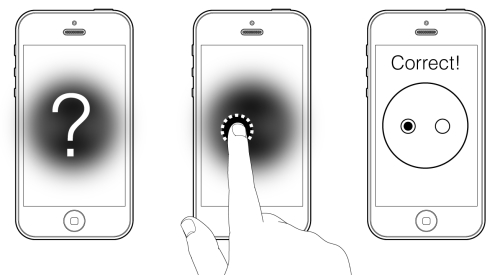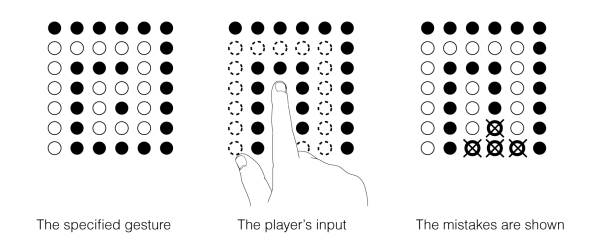Game modes in most common ways are combinations of elements and mechanics that the application has. Each one introduces their own collection of details and has their own rules, obeying the main doctrine of the game. Let's just imagine the types of gameplay a gesture game can have:
- Gestures
- Intuition
- Lights
Gestures is the most common game mode. It was explained in the game mechanics section of the current chapter. The game shows a gesture symbol. The player has to react fast in making the input and thereby, he collects points and bonuses.

One of the most unusual game modes you can utilize is intuition. It is pretty adventurous and funny. The idea is a little bit ironic. The game does not show a gesture symbol it has just generated. It shows nothing except for a black screen or a very blurry and unrecognizable image of the symbol—something in the mist. Are you intrigued? Now the most interesting part: the game waits and the player makes a hypothesis about the hidden symbol. They have to guess what is hidden. They make a gesture listening to their own intuition. Then the game shows the hidden symbol. If the player's surmise is correct, they get a lot of points. The score system can be generous and can be based on the number of the correctly predicted nodes of the gesture. It is important to show the player a statistic of their fortunes and misfortunes. Optionally, the game can show the player an innuendo or display the symbol very quickly at the very beginning of the game session. In this case, it will not be a test on intuition, but on visual memory. So, there is a space for creative experiments:

This game mode is very suitable for the spells and can be a great challenge for the player's memory and attention. The game shows a grid of dots, all of which are initially dark (turned off). Suddenly a gesture symbol is drawn by a little light that flashes on the dots; they switch on and off in a specific order. The light moves on the dots drawing a contour of a spell. It has no tail (or it is very short), so the player basically sees only one running spot of a light at a time. If the light is moving fast enough and the spell's shape is very catchy, it is not easy to remember the contour just drawn. Did the light turn left on that row or on this one?
When the light finishes traveling the screen, the player is asked to reproduce its trajectory. The dots are dark again (they may have a special color signaling they are waiting for the input). The player makes his gesture by tapping on the dots one by one. Then he has to click on the Submit button. After that, the game analyzes the input and shows all the correct nodes by green dots and the wrong ones by red signs. The player is awarded for the correct elements of the gesture and gets some negative points for the mistakes they made.
The game can hide some prizes behind some of the dots. It is also great to make the start of each game session a little bit sudden. A countdown before the beginning of the light show should be a little bit different each time. It can help to tease the player.

Additionally, each game mode has three organization models:
- Infinite: This is almost an endless game process. The player plays until they use up their lifetime variable (or lose all their game lives).
- Time: This is the time limit. Each game session is limited in time. The player can choose between the time options: 15 seconds, 30 seconds, 1 minute, and so on.
- Levels: This is a predefined collection of gestures. The game can take them from the array manually created by you or it can have special logic to generate a unique set of elements for each level.
